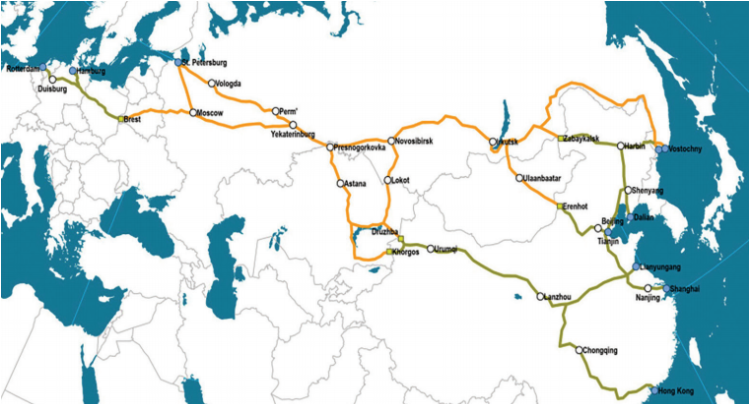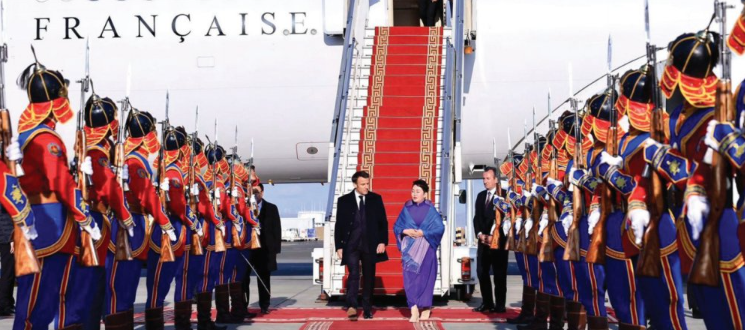 Odjargal.E of Mining Insight talked with Enkhbayar.N, an economist, and Head of the Economic and Security Research Center of the Strategic Research Institute on the opportunities and risks for Mongolia concerning geopolitical tensions, global situations, technology race, and commodity market trends, as well as investment in critical minerals.
Odjargal.E of Mining Insight talked with Enkhbayar.N, an economist, and Head of the Economic and Security Research Center of the Strategic Research Institute on the opportunities and risks for Mongolia concerning geopolitical tensions, global situations, technology race, and commodity market trends, as well as investment in critical minerals.Will geopolitical tensions lead to global evolution?
The global order is intricately influenced by key economic factors such as maritime transport, finance, and military technology. The dominance of a technologically advanced country holds the power to shape the world order. The Bretton Woods agreement, established at the Bretton Woods ski resort in New Hampshire, USA, by over 30 countries, led to the formation of the International Monetary Fund (IMF) and the World Bank. The IMF commenced its operations in the spring of 1945, followed by the opening of the World Bank the following year. Subsequently, the formation of the North Atlantic Treaty Organization (NATO) two years later played a crucial role in shaping the current global order. Even after more than 70 years, the existing system continues to exert significant influence. This was evident during the war between Russia and Ukraine, where more than 50 countries were quick to impose sanctions against Russia, collectively accounting for 60 percent of the world economy. This coalition extends beyond the European Union, encompassing the United States, NATO, and other nations. It shows the existing world order. China and Russia, possessing substantial financial and military capabilities, have been advocating for a "Global New Order" since 2015, thereby contributing to the prevailing geopolitical tensions. Geopolitical researchers are considering the armed conflict between Russia and Ukraine to be a "Superpower Struggle." While history will undoubtedly play a role in unfolding events, I believe that the current geopolitical conflicts primarily revolve around economic factors and are unlikely to lead to globalscale transformations. The backbone of the world order lies in the economic prowess, banking systems, and military might of the Western powers, with technology standing as a vital determinant of influence and power in the present era.
Military technology or...?
Chips, also known as semiconductors, serve as the foundation for various applications, not only in households but also in military and scientific fields. Semiconductors play a crucial role in enabling highresolution imaging and performing complex calculations for weather satellites. Taiwan's TCMC, a prominent player in the semiconductor industry accounting for 70-80 percent of global production, is currently manufacturing 10-nanometer semiconductors and has plans to produce 3-nanometer chips. Intel, aiming to start production by 2025, is preparing to manufacture 2-nanometer semiconductors. Furthermore, there are efforts underway with technology capable of developing 1 nanometer within the next five years. TCMC, Intel, and Samsung are establishing semiconductor factories to support technological advancements in the United States. Recently, Japan, South Korea, Taiwan, and the Netherlands collectively imposed restrictions on selling semiconductor printing technology machines to China. Additionally, these countries have decided against importing semiconductors with small nanometer sizes, potentially leading to a future transfer of technology to Russia. It is worth noting that semiconductors have significant implications for military applications, as they contribute to the development of China's military and space rockets. The competition surrounding semiconductor technology plays a vital role, and advancements in this field, such as the incredibly accurate 10-2 nanometer semiconductor, drive the race for superiority. Western countries are actively leveraging technology to maintain their dominance, and in the coming years, they are likely to continue holding an edge in terms of technological superiority.
ANTICIPATING SIGNIFICANT SHIFTS IN THE COMMODITY MARKET OVER THE NEXT 2-3 YEARS
What are your thoughts on the present global scenario, encompassing topics such as international commodity trade, supply and demand chain reform, the energy crisis, price fluctuations, and the impact of inflation during wartime?
Following the conclusion of the Cold War, the global economy experienced a period of prosperity. This era coincided with the active involvement of the World Trade Organization, leading to a growing trend of countries engaging in free trade, reducing tariffs, and dismantling trade barriers. During this cycle, China's economy exhibited significant strength, consistently growing at a rate of 8-10 percent until 2020. From an economic standpoint, Europe, North America, and China emerged as the three major centers of global development. However, China's economic growth has gradually decelerated due to factors such as a domestic real estate crisis and a slowdown in population growth. Additionally, China has encountered trade disputes with the United States. Meanwhile, Western countries have imposed sanctions on Russia in response to the conflict in Ukraine. As the largest supplier of raw materials and food globally, Russia's ability to export coal, oil, and gas to the European market has been hindered by these embargoes. The European Union, in a way, has expressed that they are no longer dependent on Russia. Historically, OPEC and Russia have influenced global oil prices and market trends. However, due to the embargo, Russian oil has become limited in the world market, resulting in a divergence between the real prices determined by the free market and those influenced by OPEC. This discrepancy in oil prices has significant implications for the global economy. Consequently, the global commodity market has undergone significant transformations, and this trend is expected to persist over an extended period. Banking and financial institutions in Western countries suggest that even if the conflict in Ukraine ceases, the embargo against Russia will likely continue for the next 2-3 years. Western sanctions will remain in place until the Russian government establishes a more democratic and peaceful administration. The current situation in Russia, our northern neighbor, is characterized by significant uncertainty and criticality. The ongoing war in Ukraine has persisted for two years, and international researchers predict that it may continue for an additional two to three years. Various scenarios are being considered regarding the outcome of the conflict, with one possibility being the fragmentation of Russia into multiple countries. Even E.V. Prigozhin, the owner of Russia's "Wagner" military group, mentioned in an interview the potential for a revolution if the situation in Russia persists for an extended period. The Russian population may come to acknowledge this reality themselves. Notably, many skilled individuals, such as engineers, technicians, and specialists, have been leaving the country and seeking refuge in foreign nations. In an attempt to curb this, the government has implemented measures like prohibiting civil servants, military personnel, and high-ranking officials from crossing the border and confiscating their passports. However, such restrictions are unlikely to be sustainable in the long run, as intellectual citizens will not accept such limitations indefinitely. Numerous researchers believe that in the medium term, Russia may undergo systemic changes.
What are the current economic interests and areas of cooperation between Russia and China?
There is a convergence of anti-Western interests between Russia and China, and one of the key areas where their interests align is trade and economy. Russia serves as a significant supplier of raw materials, while China represents a major consumer and a vast market. For China, entering into high-value contracts with Russia to secure raw materials can be advantageous in certain cases. However, it is anticipated that negotiating with the Russian side will become more challenging and potentially stressful for Chinese companies in the future. China, as a member of the UN Security Council, has made significant decisions regarding its energy strategy. For instance, China has chosen to construct a natural gas pipeline from Turkmenistan and procure combustible gas rather than pursuing the extensively discussed "Power of Siberia 2" pipeline with Russia that would have gone through Mongolia. As of 2021, China's imports include 32.0-35.0 billion cubic meters of combustible gas from Turkmenistan and over 10.0 billion cubic meters of combustible gas from Russia. From my understanding, China and the United States are the only two countries that engage in foreign trade with nations across the world. China's customs trade statistics indicate that it conducts trade with Pacific countries and island nations, presenting a wide range of options for trade partnerships. In addition to Mongolia, China imports coal from various countries, including Indonesia, Canada, Australia, Russia, and the United States. Trade relations between Russia and China differ from our company-level interactions. The supply of coal and gas between the two countries is negotiated at the highest levels of government. During Russian Prime Minister M. Mishustin's visit to China in May, discussions were held regarding the establishment of a new coal supply agreement. Russian commodity companies are currently facing economic difficulties and substantial tax pressures. This is due to the additional royalty tax imposed on mining companies as a means to finance the war when the country passed its budget last year. With reduced profit margins and limited opportunities for new investments, these companies are actively seeking opportunities to sell their raw materials abroad. The decrease in raw material prices has proven beneficial to China. Russia is investing significant capital in its raw material infrastructure, which provides it with an advantage in terms of quicker problem-solving compared to our infrastructure construction. The construction of a new railway from Yakutia's Elga field to the Pacific Sea of Agnuur commenced last year. This project aims to build a 486-kilometer railway from the Elginsk deposit to the Pacific Ocean, with a projected completion time of two and a half years. Russia recognizes the strategic importance of railways and infrastructure and is actively investing in their development.
SHIVEEKHUREN-CEKE PORT IS AN IMPORTANT PORT IN MONGOLIA'S FOREIGN TRADE STRATEGY

What are the geopolitical implications and long-term consequences of the ongoing conflict in Ukraine from our country's perspective?
As a result of its geographical proximity to the embargoed country and its significant trade partnership with us, the current situation is also having adverse effects on Mongolia. There has been a significant decline in flights through our airspace, and trade connections with Europe have been severely impacted. Of utmost concern is the fact that Mongolia now heavily relies on a single gateway to access the global market, which is Tianjin Port. Approximately 84% of our exports are directed towards China. Over the past two years, we have observed and experienced the direct consequences of any disruptions or delays in transportation through Tianjin Port. Such incidents have led to rapid price increases for our country's goods and have posed a high risk of economic crisis for the entire nation. Last year witnessed a temporary subsiding of the tensions surrounding Taiwan. However, it is important to note that the long-term goal remains the unification of the country by 2049, coinciding with the 100th anniversary of China's founding. This commitment was reaffirmed during the All-China People's Congress in March, where it was declared that "Taiwan is our land" and that efforts will be made to achieve national unity. Consequently, the underlying tension in the Pacific region continues to persist, with implications for regional dynamics and stability. The United States is actively supplying arms to Taiwan. Additionally, an agreement has been signed to expand military base operations in the Philippines. The presence of numerous US military bases in the region, starting with Japan and South Korea, adds to the overall military strength. Each aircraft carrier represents a formidable fleet, accompanied by a multitude of ships. These carriers can accommodate over 70 aircraft, highlighting the significant military force already deployed in the Pacific region. As China pursues its goal of unifying Taiwan, it faces the challenge of the American military alliance opposing such actions. The geopolitical escalation in the Pacific region emerges as a major risk that Mongolia needs to closely monitor and consider.
What measures should our country undertake to adapt to the evolving situation? In light of emerging global trends, what policies and positions do you believe Mongolia should adopt to effectively navigate the future?
China, our southern neighbor, holds a significant share of over 80% of Mongolia's export market. Given this dependency, we must maintain a pragmatic trading partner policy with China during any geopolitical conflict situation. Currently, Mongolia's primary concern is focused on fostering robust economic relations. It is imperative to ensure that our economy remains resilient in the face of potential geopolitical disruptions. In this context, a matter of discussion last spring was the need for Mongolia to establish a second import outlet. The Shiveehuren-Ceke port has emerged as a potential solution and is widely regarded as a gateway for coal exports. By diversifying our import routes and trade channels, we can enhance our economic stability and reduce vulnerability to geopolitical uncertainties. The Ceke port holds strategic significance as it is located just over 100 km away from the railway connecting Asia and Europe. This railway serves as a vital transportation link connecting the three major economic centers of the world. Transit cargo along the Trans-Siberian railway in Russia takes approximately 14 days while reaching the Khorgos port in Kazakhstan via Central Asia takes around 10-12 days. This Central Asian route is considered more efficient as it passes through multiple countries. To mitigate vulnerabilities and strengthen our trade infrastructure, it is crucial for Mongolia to swiftly connect to this transcontinental railway system. By doing so, we can compensate for any potential disruptions in Tianjin and establish alternative import routes through Sekhe port, allowing us to import goods from Central Asian countries and Turkey. The government's decision to construct a narrow gauge railway for the ShiveehurenCeke port holds strategic significance in this regard. Collaboration with Chinese transport and logistics companies is essential for maximizing the benefits of the Shiveehuren-Ceke port gateway and railway.
What about the significance of the Western Vertical Railway?
The significance of the Western Vertical Railway is likely to diminish in the future due to the current challenging and unstable situation in Russia. In light of security and strategic considerations, it is important for Mongolia to expeditiously connect to the Central Asian Railway.
UNDER THE QUOTE "OUR PROPERTY," WE HAVE INCURRED DEBTS TOWARDS RAILWAYS AND OYU TOLGOI

In 2022, Mongolia hosted high-level visits from two neighboring countries. As we move into 2023, several state visits from European Union countries have been scheduled and are already underway. The most recent visit took place on May 21 when the French President paid a visit. In June, we can expect the Parliamentary State Secretary of the Ministry of Economy and Climate of Germany and a member of the Bundestag to visit Mongolia. What is the political and economic significance of these visits to our country? From an economic point of view, will they bring new conditions and opportunities to attract investment?
American, Japanese, and German government officials from G7 member countries have previously visited Mongolia. The fourth member, France, has just arrived. This visit holds great significance for Mongolia, particularly during times of geopolitical tension. One crucial aspect of our country is achieving energy independence. G7 plays a vital role in addressing this issue. We require technology and investment from Western countries to develop non-coal energy sources and find a solution. Without any border disputes with Russia, our country has the opportunity to consider establishing a facility similar to the Aegean hydroelectric power station. This technology, known as pumped storage hydropower, is widely utilized in Southeast Asia and the South. For example, an artificial lake could be constructed on top of a mountain in the Terelj basin. During the summer, when the Tuul River floods, water could be stored in the artificial lake. Subsequently, this stored water would be used to generate hydroelectric power through a power station. Using the hydroelectric power station solely during the winter peak hours of 17:00-22:00 would be sufficient. I had the chance to witness a similar hydroelectric power plant in Japan. Located over 50 km away from Tokyo, this hydroelectric power plant was built in the middle of a mountain and is currently operational. This hydroelectric power plant can play a crucial role during natural disasters like earthquakes, as it can quickly initiate the generator. This capability becomes especially significant in ensuring a timely response and providing a power supply in emergencies. Japan, as a member country of the G7 and our closest neighbor, possesses the full potential to assist in solving hydroelectric power plant technology. Collaborating with Japan in this area can greatly contribute to our goal of achieving energy independence. In the early 2000s, Canadian businessman Robert Friedland brought international attention to Mongolia's mining industry through the discovery of the Oyutolgoi deposit. This event played a significant role in attracting foreign investments to our country. Furthermore, in the 1920s, amid conflict in Asia, American citizen Roy Chapman introduced Mongolia to historians and paleontologists through his explorations in the Gobi Desert. He achieved this by publishing books and creating films, thus presenting Mongolia to the Western world in a new and captivating way. Over the past century, Mongolia has become globally recognized for two prominent industries: dinosaurs and mining. These industries have become iconic symbols of our country. Mongolians alone cannot create the next brand to be launched globally. It requires a significant investment to discover, establish, and potentially produce it. Western countries possess all the necessary management capabilities, including financing, technology, trade networks, promotion, and the ability to attract investment. I do not believe that the influence of the "G7" will weaken in the next 20-30 years. They possess the monetary and financial resources, technological advantages, and expert skills required for such endeavors.
After the Group of 7 meeting in Japan, the President of France visited Mongolia and nearly agreed on the date of signing the investment agreement for the uranium project "Zuuvch Oovoo." This visit is interpreted from different angles and contexts. How do you observe the importance and results of this visit?
It is a rare opportunity for us that the Head of State of France, a G7 member, will be staying in our country for 5 hours. Perhaps the Ambassador played a significant role in President Emmanuel Macron's state visit to Mongolia, along with the efforts of the Orano Group. Sebastien Surun, the Ambassador of France to Mongolia, is a highly talented expert working in our country. Diplomats from developing countries who are highly educated often do not pay attention or show interest. It is of utmost importance that the Orano Group, a globally recognized company based in France, is implementing the "Transportable Heap" uranium project in Mongolia. The visit to the scandalous uranium project site further emphasizes the significance of this endeavor. Currently, there are no factories in the area. One of the two campuses serves as staff housing, while the other functions as a small laboratory for experimental production. Successful test production has been carried out, and a report has been issued. It has been determined that this deposit may be the largest uranium deposit in the world. According to the investment agreement, the government will construct the uranium processing plant within a four-year timeframe. Once the plant is constructed, it will produce products under the label of the French Orano Group. As a member of the global uranium trade and supply chain, the Orano Group will sell the products directly themselves. Yellow powder, referring to uranium, is not a commodity that is openly traded on the world market like other commonly traded commodities. It is not listed on stock exchanges and is instead traded in a closed environment with specific regulations and restrictions. Exporting uranium presents challenges due to international agreements that restrict transportation through the territory of other countries. From a security standpoint, meticulous operations are required, including prior notification to the International Atomic Energy Agency (IAEA). Transportation is limited to road and rail, as it cannot be transported by air. Depending on the destination, Mongolia will engage in agreements with neighboring countries. Considering market trends, the consumption of uranium, or yellow powder, is expected to continue growing in China. Notably, China is currently constructing 24 new nuclear power plant reactors. Geographically, this presents a favorable opportunity for our country.
It is the second biggest deal after Oyu Tolgoi. Will "Uranium" face social bias and opposition?
Let's delve into the past. In 1949, our country signed an agreement with the Soviet Union to establish a joint railway company. The Mongolian side owned 49% of the joint-stock company, and the agreement involved a 50-year ruble loan from the Russian side, amounting to MNT 368 million (calculated at the exchange rate of that time), with an interest rate of 1%. The Mongolians fully paid Russia's substantial debt by 2003. Additionally, during the war, Mongolia provided 300 kg of gold, along with food and goods, to the Soviet army. If we convert the loan from the railway agreement to gold, it would amount to nearly 800 kg. It is indeed regrettable that we paid less than the value of the gold we provided for free over 50 years. The railway agreement and the investment agreement of the Oyu Tolgoi project do share similarities in terms of creating debt through loans. A notable dispute emerged when a loan was obtained while holding a 34 percent ownership stake in the Oyu Tolgoi project. We have numerous real examples and lessons that clearly illustrate the consequences of government ownership in various projects. To engage in the third significant deal, the government doesn't need to own a substantial portion of Mongolia's share in the "Zuuvch Oovo" project. Holding up to three shares is sufficient if ownership is desired. Essentially, there is no significant difference in quality between owning three percent and 34 percent. Let us carefully understand that if a uranium processing plant is established, Mongolia does not necessarily need to engage in technology solutions and product trade. However, we must pay special attention to the environmental impact, water resource management, land usage, and the associated fees that may be incurred. France possesses the knowledge and experience in technology and trade, while the implementing party decides the management approach. This is how Western countries attract investment. Insisting that certain assets are "our state property" has resulted in significant debt burdens in projects such as the railway, Erdenet Mining Corporation, Mongolrostsvetmet plant, and the Oyu Tolgoi project. Therefore, it is essential to provide the public with a correct understanding. Yellow powder production is not directly linked to the construction of nuclear power plants. The technology will be localized in Mongolia, and taxes will be imposed. This will lead to positive economic outcomes, including increased foreign trade, exports, and inflows of foreign exchange.
Would you like to share your opinion on our country's potential for having an atomic power plant?
Having a nuclear power plant has not yet materialized for our country; it remains a matter for the future. Recently, the world has been leaning towards small nuclear capsule reactors as the chosen technology. In due course, a single small reactor that only requires recharging once every 20 years can be constructed in the Gobi region, providing ample power for the entire industry. If the Gobi region independently determines its energy supply, the power generated by the three regions combined is already sufficient, even considering the current capacity of the central grid. Unlike China and Turkey, Mongolia does not have a significant energy consumption demand. At the very least, nuclear power plants with microreactors represent the guiding principle for addressing Mongolia's energy challenges. However, it is important to acknowledge that implementing such a solution will require a significant amount of time.
IT IS AN OPPORTUNE TIME TO ATTRACT WESTERN INVESTMENT IN CRITICAL MINERALS, URANIUM, AND ESSENTIAL RAW MATERIALS SECTORS
The main focus of the high-level visits is the transition to clean energy, which includes cooperation in the field of critical minerals and rare earth elements. Are they interested in Mongolia's rare earth elements?
Western countries are showing interest in Mongolia's abundant raw material resources, particularly during these geopolitically unstable times. They aim to reduce their dependence on critical minerals sourced from China. This objective has been defined as a policy and included in the European Union's strategic document on energy and technology. Western nations are allocating significant funds for domestic exploration of critical minerals. Therefore, it is an advantageous period for Mongolia to seize opportunities to attract investment, generate tax revenue, initiate joint projects, and localize technology. Mongolia possesses significant potential with several identified and discovered deposits of critical minerals. By attracting investment, there is the possibility of making world-class discoveries through further exploration and drilling. Western countries are keen on establishing and increasing reserves in the mineralization and deposits found within our country. Hence, there is mutual interest from both sides. Mongolia has a favorable opportunity to engage in cooperation with Western investors in the field of critical minerals, uranium, and essential raw materials without creating any barriers.
Is it possible for Mongolia to establish its position in the supply chain of critical minerals?
It will be possible for Mongolia to establish its position in the supply chain of critical minerals if the necessary technology is available. In the case of rare earth elements, Mongolia requires a forward-thinking policy. The deposits of rare earth elements discovered in our country are known to have significant metal impurities. Geologists and archaeologists with expertise in the field explain that the ore contains around 7-8 different types of elements. Industry experts further emphasize that the processing technology required to separate each element in a step-by-step manner can be both complex and costly. Western countries possess advanced technology for extracting and processing rare earth elements from ore. However, it is important to note that the demand for each specific rare earth element can vary. The dynamic nature of technological innovation and evolution further influences the demand for these elements. Therefore, it becomes crucial to conduct detailed studies to determine which of the rare elements discovered in Mongolia will be in high demand in the future and in which industries they will be utilized. Realistically evaluating our current deposits, it is reasonable to assume that 2-3 main types of elements will be extracted. Consequently, the suggestion made by our scientists and geologists to prioritize and introduce the selected deposits into the economic cycle one by one holds merit.
How can we attract investment?
China, the second-largest economy in the world, and Russia, the 11th-largest economy, are important trade partners with whom Mongolia engages in communication and trade. Furthermore, our nation holds discussions on significant matters with the G7 countries. In such instances, it is observed that there is a discrepancy between their words and actions, as they fail to follow through on their discussions. For example, during German Chancellor Angela Merkel's visit to Mongolia in 2011, the topic of joint research on rare earth elements was discussed. However, many of the issues discussed during these negotiations have not been implemented to a significant extent up until now. The instability of the government and the appointment of inexperienced individuals are driving away investors. If Mongolia continues to be careless, and negligent, and overlooks such matters, it may struggle to actively participate in future international trade relations. Parliamentary elections are scheduled to take place next year. Regardless of the election results, the Mongolian government must adhere to its commitments and promises. Failure to do so may lead to a decrease in the significance of high-level visits. Currently, the mining sector remains the only sector with a relatively advantageous environment for investment in Mongolia. There may be limited opportunities in the energy sector. Investors often show interest in Mongolia due to its proximity to the Chinese market. Our country needs to maintain normal, stable trade relations with China, ensuring efficient transportation and minimizing bottlenecks at the border ports. By creating favorable infrastructure conditions, Mongolia can attract more investment to the country.
The construction of the long-discussed railway in three directions has been completed, and transportation has commenced. However, the task of connecting the railways across the border between the two countries is still pending. Considering this development, how do you envision the prospects of trade between Mongolia and China once the railway is fully operational?
In reality, we have not treated ourselves well in this regard. In 2008, a license was initially granted to the private sector for the construction of a narrow-gauge railway, but it was abruptly canceled and a decision was made to build a broad-gauge railway instead. Despite years of discussions with the Chinese side regarding the connection of all border ports by rail, the protocol between the governments of the two countries has remained stagnant at the ShiveekhurenSekhe port. After more than 10 years of "struggle," it is finally expected that the Shiveekhuren-Ceke port will be connected this fall. However, the shortest and main port, the Gashuunsukhait-Gantsmod port railway, remains unconnected. Unfortunately, our people have not been diligent in implementing the protocols that were agreed upon by the governments of both countries and have at times violated them as they pleased. Despite China's proposal to connect with the Gantsmod port, they chose to construct the Tavantolgoi-Gashuunsukhait railway in their manner, disregarding the suggested route. It was even built with a broad gauge. Despite claims that narrow-gauge railways are dangerous, Russia has successfully connected with China through two narrow-gauge railways in the Far East region. Only after 10 years have passed, did we realize that infrastructure and railways should be efficient and compatible in terms of standards. Thus, we decided to lay the Zuunbayan-Khangi railway on the border port section with both wide and narrow gauges. In general, solutions and decisions regarding international standard railways are not made by politicians. Depending on which party is in power, and without a long-term strategic policy of the state, the issue has been overshadowed by the "narrow" interests of individual companies. The development of railways is not solely the concern of any particular company, but rather the interest of Mongolia as a whole. In the long run, it is crucial to have a competitive and reliable transportation infrastructure that offers low costs and eliminates the additional expenses of loading and unloading. Infrastructure is not solely a matter of domestic concern but also encompasses international relations and trade. It is a policy that necessitates meticulous consideration, beginning with geopolitics and energy independence.
Can our country achieve its goal of increasing trade with our southern neighbor, specifically supplying 40-50 million tonnes of coal to the market?
It would be considered a significant achievement if Mongolia can maintain its raw material trade at the level of USD 8-9 billion, considering China's numerous options and fierce competition. China's coal production reached 4.4 billion tonnes last year, and it is expected to remain at a similar level this year. If domestic production meets the demand, imports are unlikely to increase. China's National Development and Reform Commission set quotas for coal imports from Mongolia, and Mongolia must maintain a coal supply of 35 million tonnes in the next three years. Given the economic embargo imposed by Russia, it is important not to decrease the amount of coal exported. However, the possibility of reaching the target of 40-50 million tonnes of coal exports per year is currently considered highly challenging and unlikely. If we do not exercise caution in our foreign trade practices, careless and inappropriate statements made by some of our ministers can have negative consequences. The buyer country pays close attention to such remarks. The trading of Mongolian coal is predominantly carried out by companies and a limited number of specialists who focus primarily on the company level rather than considering long-term national-level issues. The lack of a comprehensive foreign trade policy and a shortage of experts in this field is evident from the current state of coal export trade and commerce.
There appears to be a tendency to criticize online coal trading from the buyer's perspective. What are the issues at hand?
Foreign trade in our country is facing a challenging situation. Last year, when the issue of "coal theft" became a public concern, the Mineral commodity Exchange Law was approved on December 23, 2022. It appears that the bill was discussed for 20 days. This law aims to regulate the operation of the commodity exchange. However, it makes half-hearted attempts to regulate foreign trade. For example, Article 14.1 of the Law on Mineral commodity Exchange states that "The trading price of the exchange shall be announced at the price of the border port of the bordering country." Article 14.2 states that "The trading price of the exchange shall be consistent with the international market price, equal and fair, based on the principle of market supply and demand." And Article 14.3 states that "During exchange trading, the price of the contract shall be determined by the agreement of the parties on the price announced by the exchange." These provisions govern foreign trade. I have repeatedly warned that Article 14.1 should not be included in Mongolia's law. Foreign trade has established standards and rules that have been understood and practiced worldwide for centuries. These standards define the terms of delivery of products from the seller to the buyer. The terms of the Mongolian coal trade, such as "picking up from outside the seller," "delivery to a specific non-border point," and "delivery to the border," have been clearly defined internationally. It is very wrong from the perspective of foreign trade policy to limit the choices available to all parties through legislation. In the sense of "take it on our terms, stop if you don't," the buyer is treated as "inferior". No country in the world has been regulated solely by law in this manner. Both Mongolia and China are members of the World Trade Organization, and trade is conducted based on the conditions and agreements established in international trade. Several electronic trading initiatives for Mongolian coal have mostly failed. According to the Mongolian Stock Exchange, 1.3 million tonnes of coal were traded, but only about 600,000 tonnes were delivered to the border. When I visited the border port as part of my assignment, I observed that the coal traded on the exchange was not accepted because the Chinese side did not have a place to unload it.
Why?
The interests of the buyer are being violated. The law will come into effect on June 30. The Ministries of Mining, Finance, and Economy have been responsible for conducting foreign trade in our country. There was an estimation to export 40 million tonnes of coal per year, but this goal remains unachieved and is merely a "dream" for Mongolians. Other countries, to reach such levels, formulate roadmaps, engage in high-level visits and negotiations, make infrastructure decisions, and establish step-by-step agreements. However, we are attempting to address these issues domestically. It is important to understand that foreign trade is not solely dependent on the laws of our country. When approving the law on the exchange of mining products, the primary market should be carefully considered. Mongolia primarily supplies its mineral products to one market. If the southern neighbor closes the border for a month, we would need to reconsider the law. It is crucial to recognize that we are trading in a competitive market at every level. China, with 24 out of 27 provinces having abundant coal reserves and 5800 coal mines in the country, enjoys a wide range of supplier options. It produces sufficient domestic coal and also engages in state-level negotiations for coal supply with Russia. The provinces in China with the largest coal mines, producing over 200 million tonnes per year, bordering Mongolia. As evident, our country does not possess a significant advantage in terms of coal. It will take two or three years to increase the export volume of Mongolian coal to 40-50 million tonnes.
ENERGY LIMITS MONGOLIA'S ECONOMIC GROWTH
With abundant coal reserves, our country is unable to build power plants, and the domestic energy sector has reached a "disastrous" level. How can we restore industrialization while barely meeting domestic consumption with imported electricity?
There are power outages in the Nariin Sukhait coal mine. There are no roads available for product transportation. How can a business develop and expand in such a situation? An oil refinery is being constructed in Atanshiree soum. Once the refinery starts operating, it cannot be halted. It operates for 365 days until the next maintenance period. Similar to the Angarsk oil plant, from which our country imports oil products, performing annual maintenance, the energy situation is currently reliant on imports. Three energy sources are being imported from the border of Umnugovi province, and the same applies to three sources on the outskirts of Bayankhongor province. In the next 10 years, heavy industries such as oil, uranium, liquefied gas processing, Tavan Tolgoi coal washing and beneficiation, and a black metallurgical complexwill be constructed in the Gobi region. However, we have not yet been able to establish the necessary conditions to ensure uninterrupted production energy supply and prevent high voltage drops. Whether the policy of "revival of industrialization" will be implemented depends on the energy potential of our country. Mongolia's economic growth is limited by energy constraints. In the past, our country focused on establishing a household energy system that covered all regions. However, the challenge lies in the transmission of energy over long distances. Currently, electricity is transmitted from the producers in Ulaanbaatar, Darkhan, and Erdenet, spanning a distance of 1000 km. Due to this long transmission distance, the voltage of the electricity decreases significantly, resulting in insufficient power when it reaches the end users, causing even the lightbulbs to fail to turn on. All energy transmission is based on alternating current, which leads to significant losses during longdistance transmission. The technology in the energy industry is lagging. The first potential solution is to divide the energy system into two parts: the central and northern regions. There is a pressing need for technological innovation to address the shortfall in grid electricity storage, promote renewable energy sources, and resolve peak-hour loads. Mining will continue to dominate our country's economy until 2030. The Gobi region holds deposits and minerals that can contribute to the welfare of Mongolians. However, the lack of infrastructure hinders its efficiency. In 2009, the World Bank conducted a study to assess and calculate the necessary infrastructure for the Gobi region in Mongolia. Now is the time to take action. The activities surrounding Tavan Tolgoi have been disorganized and chaotic. The project's feasibility study was incomplete, and the railway connection from the mine to Tsagaankhad was severed. The Ministry of Road and Transport Development has recently announced the initiation of a feasibility study for the railway section up to the Gashuunsukhait port. The feasibility study for the railway is expected to be completed within this year, and the construction process is estimated to take 2-3 years. The Tavan Tolgoi railway station has been constructed within the mine itself, serving as a connection point for the Dalanzadgad-Shiveekhuren-Ceke railway. Meanwhile, efforts to connect the Shiveekhuren-Sekhe port railway have commenced, although there may be a lack of coherence in the overall planning and execution of these projects.
Are you saying that if the infrastructure is not properly planned, it will hinder the implementation of other projects?
Exactly. Mining is not just about excavation; it involves road transportation, foreign trade, energy, personnel, technology, and production. Each minister has focused on their respective sector-related issues, dividing the project in such a way. The new airport, constructed with a loan from the Japanese government, serves as an illustrative example. The airstrip and terminal were built by the Japanese, while other infrastructure facilities were constructed by the Mongolian side, but all of them were delayed by 2-3 years. We Mongolians fail to grasp the notion that a complex project requires a comprehensive and simultaneous implementation approach. An oil refinery is an exceptionally unique and complex engineering project that must be properly executed from the outset. It involves a complex network of crude oil pipelines, refining production, transportation, and sales. Currently, the first two aspects are being addressed. However, there is a shortage of crude oil to support a production capacity of 1 billion tonnes. It appears that only 30-40 percent of the required amount can be sourced from the currently discovered reserves. To fully utilize the plant's capacity, additional crude oil will need to be procured from Russia. Manufacturing products will not be inexpensive due to the complexity of the engineering facilities involved. Firstly, the construction is financed through a subsidized but interest-bearing loan from the Government of India. Secondly, the installation of crude oil pipelines is a costly endeavor. It involves underground burial, electrical heating, pumping systems, and other expenses. The expenses incurred by the new factory will need to be covered to repay the loan. As a result, the prices of manufactured products are not expected to be significantly lower than the current price of gasoline. There is an option for the government to address this issue by registering the loan from the Government of India with the Ministry of Finance and initiating repayment. Once the debt is cleared, the price of Oil Refinery products can be reduced. Shipping and sales issues remain unclear, particularly regarding the transportation of a significant portion of the fuel produced by the factory via railway. Currently, Ulaanbaatar Railway does not possess dedicated tank cars for fuel transportation. The matter of railway infrastructure will need to be revisited during the sale of petroleum products. The transportation infrastructure is not adequately prepared. These types of challenges are likely to arise in future production projects as well. To ensure the successful implementation of such projects, it is crucial to plan the major undertaking thoroughly, considering all its components, and address the issues with the participation of all involved parties.
Thank you for the interview.
Mining Insight Magazine, №05 (018)



























